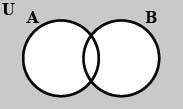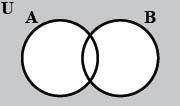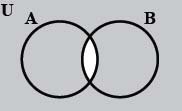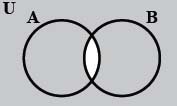NCERT Solutions Class 11 Maths
The NCERT Solutions in English Language for Class 11 Mathematics Chapter – 1 Sets Exercise 1.5 has been provided here to help the students in solving the questions from this exercise.
Chapter 1 (Sets)
Chapter : 1 Sets
- NCERT Class 11 Maths Solution Ex – 1.1
- NCERT Class 11 Maths Solution Ex – 1.2
- NCERT Class 11 Maths Solution Ex – 1.3
- NCERT Class 11 Maths Solution Ex – 1.4
- NCERT Class 11 Maths Solution Ex – 1.6
| Exercise – 1.5 |
1. Let U = {1, 2, 3; 4, 5, 6, 7, 8, 9}, A = {1, 2, 3, 4}, B = {2, 4, 6, 8} and C = {3, 4, 5, 6}. Find
(i) A’
Solution – We know that this is the complement of set A i.e, it is the subset of U.
So, A’ = {5, 6, 7, 8, 9}
(ii) B’
Solution – We know that this is the complement of set B i.e, it is the subset of U.
So, B’ = {1, 3, 5, 7, 9}
(iii) (A ∪ C)’
Solution – This is the complement of union of set A and set C i.e, U – (A∪ C)
So, A ∪ C = {1, 2, 3, 4, 5, 6}
⇒ U – (A ∪ C)
So, (A ∪ C)’ = {7, 8, 9}
(iv) (A ∪ B)’
Solution – This is complement of union of set A and set B i.e, U- (A ∪ B)
So, A∪ B = {1, 2, 3, 4, 6, 8}
⇒ U – (A ∪ B)
So, (A ∪ B)’ = {5, 7, 9}
(v) (A’)’
Solution – This is the complement of set A i.e, (A’)’ = A
So, (A’)’ = {1, 2, 3, 4}
(vi) (B – C)’
Solution – (B – C) = elements in B but not in C
(B – C) = {2, 8}
⇒ U – (B – C)
So, (B – C)’ = {1, 3, 4, 5, 6, 7, 9}
2. If U = {a, b, c, d, e, f, g, h}, find the complements of the following sets:
(i) A = {a, b, c}
Solution –
Complement of set A = A’
A’ = U – A
A’ = {a, b, c, d, e, f, g, h} – {a, b, c}
A’ = {d, e, f, g, h}
(ii) B = {d, e, f, g}
Solution – Complement of set B = B’
B’ = U – B
B’ = {a, b, c, d, e, f, g, h} – {d, e, f, g}
B’ = {a, b, c, h}
(iii) C = {a, c, e, g}
Solution – Complement of set C = C’
C’ = U – C
C’ = {a, b, c, d, e, f, g, h} – {a, c, e, g}
C’ = {b, d, f, h}
(iv) D = {f, g, h, a}
Solution – Complement of set D = D’
D’ = U – D
D’ = {a, b, c, d, e, f, g, h} – {f, g, h, a}
D’ = {b, c, d, e}
3. Taking the set of natural numbers as the universal set, write down the complements of the following sets:
(i) {x: x is an even natural number}
(ii) {x: x is an odd natural number}
(iii) {x: x is a positive multiple of 3}
(iv) {x: x is a prime number}
(v) {x: x is a natural number divisible by 3 and 5}
(vi) {x: x is a perfect square}
(vii) {x: x is perfect cube}
(viii) {x: x + 5 = 8}
(ix) {x: 2x + 5 = 9}
(x) {x: x ≥ 7}
(xi) {x: x ∈ N and 2x + 1 > 10}
Solution – We know that U = N: Set of natural numbers
(i) {x: x is an even natural number}´ = {x: x is an odd natural number}
(ii) {x: x is an odd natural number}´ = {x: x is an even natural number}
(iii) {x: x is a positive multiple of 3}´ = {x: x ∈ N and x is not a multiple of 3}
(iv) {x: x is a prime number}´ ={x: x is a positive composite number and x = 1}
(v) {x: x is a natural number divisible by 3 and 5}´ = {x: x is a natural number that is not divisible by 3 or 5}
(vi) {x: x is a perfect square}´ = {x: x ∈ N and x is not a perfect square}
(vii) {x: x is a perfect cube}´ = {x: x ∈ N and x is not a perfect cube}
(viii) {x: x + 5 = 8}´ = {x: x ∈ N and x ≠ 3}
(ix) {x: 2x + 5 = 9}´ = {x: x ∈ N and x ≠ 2}
(x) {x: x ≥ 7}´ = {x: x ∈ N and x < 7}
(xi) {x: x ∈ N and 2x + 1 > 10}´ = {x: x ∈ N and x ≤ 9/2}
4. If U = {1, 2, 3, 4, 5,6,7,8, 9}, A = {2, 4, 6, 8} and B = {2, 3, 5, 7}. Verify that
(i) (A U B)’ = A’ ∩ B’
Solution –
⇒ (A ∪ B)’= U – (A ∪ B)
⇒ {1, 2, 3, 4, 5, 6, 7, 8, 9} – {2, 3, 4, 5, 6, 7, 8}
⇒ (A ∪ B)’ = {1, 9}
A’ ∩ B’ = (U – A) ∩ (U – B)
⇒ {1, 3, 5, 7, 9} ∩ {1, 4, 6, 8, 9}
⇒ A’ ∩ B’ = {1, 9}
Hence, Verified!!! (A ∪ B)’ = A’ ∩ B’
(ii) (A ∩ B)’ = A’ U B’
Solution –
⇒ (A ∩ B)’ = U – (A ∩ B)
⇒ {1, 2, 3, 4, 5, 6, 7, 8, 9} – {2}
⇒ (A ∩ B)′ = {1, 3, 4, 5, 6, 7, 8, 9}
A’ ∪ B’= (U – A) ∪ (U – B)
⇒ {1, 3, 5, 7, 9} ∪ {1, 4, 6, 8, 9}
⇒ A′ ∪ B′ = {1, 3, 4, 5, 6, 7, 8, 9}
Hence, Verified!!! (A ∩ B)′ = A′ ∪ B′
5. Draw appropriate Venn diagram for each of the following:
(i) (A U B)’
Solution –

(ii) A’ ∩ B’
Solution –

(iii) (A ∩ B)’
Solution –

(iv) A’ U B’
Solution –

6. Let U be the set of all triangles in a plane. If A is the set of all triangles with at least one angle different from 60°, what is A’?
Solution –
U = set of all triangles in plane
A = set of all triangles with at least one angle different from 60°
A’ = set of all triangles with no angle different from 60° i.e, set of all triangles with all angles 60°
A’ is the set of all equilateral triangle.
7. Fill in the blanks to make each of the following a true statement:
(i) A U A’ = ________
(ii) Φ′ ∩ A = ________
(iii) A ∩ A’ = ________
(iv) U’ ∩ A = ________
Solution –
(i) A ∪ A′ = U
(ii) ∅′ ∩ A = A
(iii) A ∩ A′ = ∅
(iv) U′ ∩ A = ∅

